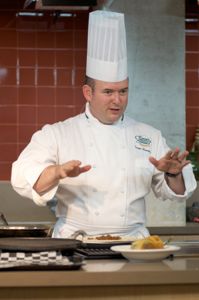Mayo’s Clinic: Keeping a Professional Journal
 Whether you maintain one or 21, building the practice of keeping a journal and recording key ideas and activities can very useful for three important reasons.
Whether you maintain one or 21, building the practice of keeping a journal and recording key ideas and activities can very useful for three important reasons.
By Dr. Fred Mayo, CHE, CHT
Last month, we discussed strategies for retaining students in our courses and programs. This month and next month, we will talk about professional journals—not published in scholarly and trade journals, but notebooks or diaries in which one writes ideas, feelings and reflections so that they can be referenced in the future.
This month, we will discuss the power and value of a keeping a journal, whether you are a student, teacher or administrator.
Types of Journals
There are many types of notebook journals that journal individuals use. Kate Davis, on www.darktea.com, lists 15 (time-capsule journal, specific-topic journal, dream journal, travel journal, reading journal, specific-timeframe journal, group or family journal, gratitude journal, personal-development journal, project journal, gardening journal, meditation journal, planning journal, creativity journal and quick journal) and Shoshana Jackson on www.knoji.com lists 20 (family journal, couples journal, relationship journal, letter journal, birthday journal, memory journal, gratitude journal, prayer journal, good thoughts or affirmations journal, dream journal, focus journal, joke journal, book or movie journal, recipe journal, hobby journal, sports journal, travel journal, health journal, diet and exercise journal and finance journal.)

 Are you dooming your students to failure by not focusing enough attention on helping them find and keep jobs after graduation?
Are you dooming your students to failure by not focusing enough attention on helping them find and keep jobs after graduation? There should be no room for variance from a standard of expectation among all stakeholders—employers, faculty, parents and the students themselves. To ensure that culinary grads meet acceptable skill and aptitude standards, Chef Sorgule suggests employing a “passport.”
There should be no room for variance from a standard of expectation among all stakeholders—employers, faculty, parents and the students themselves. To ensure that culinary grads meet acceptable skill and aptitude standards, Chef Sorgule suggests employing a “passport.” Potato prep problems? Your students are one click away from the solution. Questions about au gratin, baked, mashed, potato salad and french fries are answered online.
Potato prep problems? Your students are one click away from the solution. Questions about au gratin, baked, mashed, potato salad and french fries are answered online. The 2013 initiative, which has gained much chef and operator support from states bordering the Gulf of Mexico, continues to strive to ensure sustainability of red snapper, grouper and other fish for sale in foodservice.
The 2013 initiative, which has gained much chef and operator support from states bordering the Gulf of Mexico, continues to strive to ensure sustainability of red snapper, grouper and other fish for sale in foodservice. Kendall College is proud to announce the release of its first culinary publication, Sharing Our Global Passion: Recipes from 22 World Class Chefs ($25), a compilation of recipes that reflect the backgrounds, professional training and world experiences of faculty in the School of Culinary Arts. Published by the preeminent culinary-arts educational experience in the Midwest, this book celebrates the diversity of global cuisine in both classic style and modern interpretation.
Kendall College is proud to announce the release of its first culinary publication, Sharing Our Global Passion: Recipes from 22 World Class Chefs ($25), a compilation of recipes that reflect the backgrounds, professional training and world experiences of faculty in the School of Culinary Arts. Published by the preeminent culinary-arts educational experience in the Midwest, this book celebrates the diversity of global cuisine in both classic style and modern interpretation. The Baker College of Port Huron student-operated, fine-dining restaurant and bar at the Culinary Institute of Michigan (CIM) has opened its doors, serving up Michigan products and beautiful local views. The CIM Port Huron is located at 2000 St. Clair Street, Port Huron.
The Baker College of Port Huron student-operated, fine-dining restaurant and bar at the Culinary Institute of Michigan (CIM) has opened its doors, serving up Michigan products and beautiful local views. The CIM Port Huron is located at 2000 St. Clair Street, Port Huron. A group of students from The Culinary Institute of America (CIA) campus in Hyde Park, N.Y., is spending the first semester of senior year at the college’s campus in San Antonio, Texas, focusing on the ingredients, techniques and cultural traditions of Latin American cuisines. It is part of the CIA’s Latin Cuisines Concentration, which launched May 5—Cinco de Mayo.
A group of students from The Culinary Institute of America (CIA) campus in Hyde Park, N.Y., is spending the first semester of senior year at the college’s campus in San Antonio, Texas, focusing on the ingredients, techniques and cultural traditions of Latin American cuisines. It is part of the CIA’s Latin Cuisines Concentration, which launched May 5—Cinco de Mayo. For those visiting Chicago for this year’s National Restaurant Association Restaurant, Hotel-Motel Show, mouths water and palates yearn for one of the City of Big Shoulders’ culinary claims to fame. And among pies, four take the cake.
For those visiting Chicago for this year’s National Restaurant Association Restaurant, Hotel-Motel Show, mouths water and palates yearn for one of the City of Big Shoulders’ culinary claims to fame. And among pies, four take the cake.